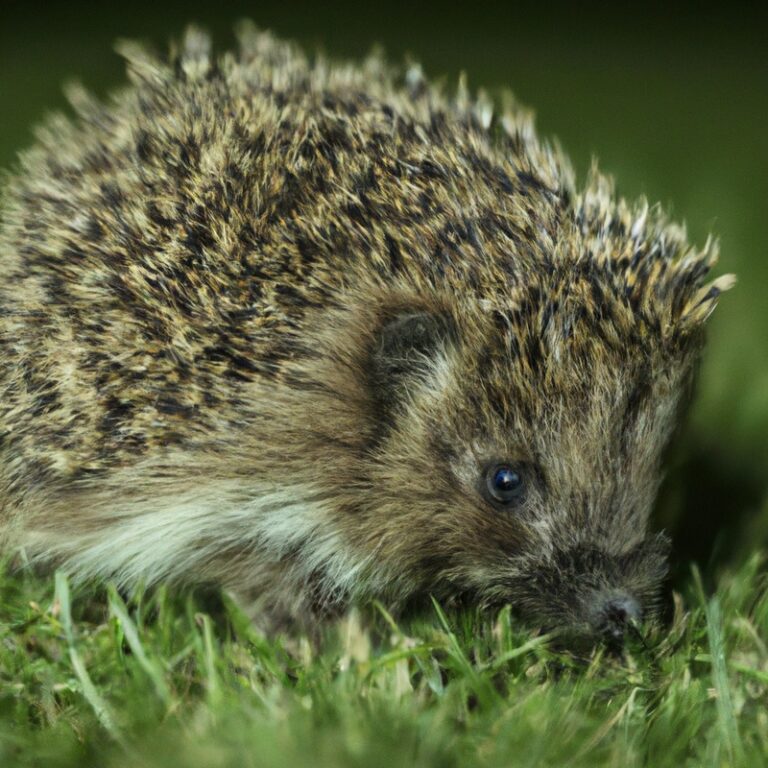How To Create a Hedgehog-Friendly Water Source?
Key Takeaways:
- Provide a shallow and stable water source for hedgehogs to drink from.
- Make sure the water source is easily accessible and located near hedgehog habitats.
- Avoid using chemicals, such as chlorine, in the water source.
- Regularly clean and refill the water source to ensure it remains clean and fresh for hedgehogs.
Are you a fan of hedgehogs and want to create a safe haven for them in your garden?
Well, you’re in luck! Hedgehogs need water just like any other creature, but finding a reliable water source can be a challenge for them.
That’s where you come in.
In this article, we’ll explore the importance of water for hedgehogs and the common challenges they face in finding it.
We’ll also discuss how to choose the right water source, design a hedgehog-friendly setup, and maintain it properly.
Plus, we’ll share some tips on attracting hedgehogs to your water source and answer some frequently asked questions.
So, get ready to be a hedgehog hero by creating a hedgehog-friendly water source!
| Steps | Description |
| Gather materials | Find a shallow dish or container that is filled with clean water |
| Choose a location | Place the water source in a quiet and safe area, away from direct sunlight and predators |
| Add stepping stones or ramps | Hedgehogs might struggle to climb out of deep containers, so provide a way for them to easily access and exit the water source |
| Keep it clean and fresh | Regularly clean the water dish and refill it with fresh water to prevent the growth of bacteria |
| Monitor the water source | Check the water source daily to ensure it is not contaminated or damaged |
| Spread the word | Inform your community about hedgehog-friendly water sources and encourage others to create them |
Why Water Sources Are Important for Hedgehogs
Water sources are vital for hedgehogs to stay hydrated and maintain their overall health.
The Importance of Water for Hedgehogs
Water is essential for hedgehogs to survive.
Hedgehogs need water to stay hydrated and maintain their overall health.
Water helps regulate their body temperature and aids in digestion.
Providing a water source in your garden or outdoor space is important to ensure hedgehogs have access to clean, fresh water at all times.
A shallow dish or bowl with water can serve as a simple and effective water source for hedgehogs.
Just make sure to check and refill it regularly to keep it clean and hygienic.

Common Challenges Hedgehogs Face in Finding Water
Hedgehogs face several challenges when it comes to finding water.
For starters, their natural habitats are often drying up due to urbanization and climate change.
This makes it difficult for them to find natural water sources like streams or ponds.
Additionally, hedgehogs are nocturnal creatures, which means they tend to forage for food and water at night when many water sources may not be easily accessible or available.
Lastly, hedgehogs are small and vulnerable animals, so finding a safe and secure water source can be a challenge as they need to avoid predators while quenching their thirst.
Choosing the Right Water Source for Hedgehogs
When creating a water source for hedgehogs, it’s important to choose the right option.
Natural Sources of Water for Hedgehogs
Hedgehogs can find water from various natural sources in their environment. They often drink from ponds, streams, or shallow pools of water.
Garden features like bird baths can also be a convenient water source for hedgehogs, as long as they can access it safely.
It’s important to ensure that these water sources have a gradual slope or a shallow edge so that hedgehogs can comfortably access and exit the water. Providing fresh water in your garden is a simple and effective way to create a hedgehog-friendly environment.

Artificial Water Sources for Hedgehogs
Artificial water sources can be a great addition to your garden to provide hedgehogs with a much-needed hydration spot.
A shallow dish or basin with a gentle incline should be placed in a quiet and sheltered area, away from direct sunlight.
Make sure to keep the water clean and fresh by changing it regularly.
Avoid deep containers that can pose a drowning risk for hedgehogs.
Remember to check the water source daily, especially during hot and dry weather.
Designing a Hedgehog-Friendly Water Source
When designing a hedgehog-friendly water source, consider the location, size, depth, and safety precautions.
Location and Placement of the Water Source
To create a hedgehog-friendly water source, consider the location and placement carefully.
Place the water source in an area that is easily accessible for hedgehogs, but away from busy roads or areas with high human activity.
Ensure the water source is shallow enough for hedgehogs to drink from without danger of drowning.
A dish or shallow tray can work well.
Keep the water source clean and fresh by regularly changing the water.
Consider placing the water source near a hedge or shrub to provide cover for the hedgehogs while they drink.
Size and Depth of the Water Source
When designing a hedgehog-friendly water source, the size and depth of the water source are important factors to consider.
The water source should be shallow enough for hedgehogs to access and exit easily, but deep enough for them to drink and bathe comfortably.
Aim for a depth of around 2-3 inches, which will prevent the water from evaporating too quickly while still being safe for hedgehogs.
Additionally, ensure that the water source is wide enough for hedgehogs to move around and access the water without feeling cramped.
Safety Considerations for Hedgehogs
To ensure the safety of hedgehogs, there are a few key considerations to keep in mind:
- Avoid pesticide use: Pesticides can be harmful to hedgehogs and their food sources. Opt for natural pest control methods instead.
- Provide easy access: Ensure that any water sources or ponds have gentle slopes or ramps to allow hedgehogs to enter and exit safely.
- Check for hazards: Regularly inspect your garden for potential dangers such as netting, wires, or chemicals that hedgehogs might get tangled in or ingest.
- Create sheltered areas: Hedgehogs need safe and sheltered spots to rest and hibernate. Providing hedgehog houses or dense vegetation can help protect them from predators.
- Limit human interaction: Hedgehogs are wild animals and should be observed from a distance. Minimize handling to reduce stress and the risk of transmitting diseases.
By keeping these considerations in mind, you can create a safer environment for hedgehogs to thrive in your garden.
Maintaining the Hedgehog-Friendly Water Source
To maintain a hedgehog-friendly water source, regular cleaning and refilling are necessary. Additionally, taking steps to prevent mosquitoes and pests and encouraging hedgehogs to use the water source is important.
Regular Cleaning and Refilling
Regular cleaning and refilling of the hedgehog-friendly water source is essential. It ensures the water remains fresh and clean, promoting the health and well-being of hedgehogs.
Here’s how you can maintain it:
- Clean the water source regularly using a mild detergent or soap and a brush. Rinse thoroughly to remove any soap residue.
- Refill the water source frequently to ensure there is always fresh water available for hedgehogs.
- Check for any debris or contaminants in the water and remove them promptly.
- Keep the water source in a shaded area to prevent excessive evaporation and algae growth.
- If you notice any signs of mold or algae, clean and disinfect the water source using a mild bleach solution.
By regularly cleaning and refilling the water source, you create a safe and inviting environment for hedgehogs to quench their thirst.
Preventing Mosquitoes and Other Pests
To prevent mosquitoes and other pests from invading your hedgehog-friendly water source, there are a few simple steps you can take. First, make sure the water source is properly maintained and cleaned regularly.
Remove any standing water and clean out the container to eliminate mosquito breeding grounds.
Additionally, you can consider using natural mosquito repellents like citronella or installing mesh covers to keep pests away. Finally, keep the surrounding area tidy and free from debris to discourage pests from nesting nearby.
By taking these precautions, you can ensure a pest-free environment for your hedgehog’s water source.
Encouraging Hedgehogs to Use the Water Source
To encourage hedgehogs to use the water source you’ve created, there are a few simple steps you can take.
- Make sure the water source is easily accessible for hedgehogs. Place it in a quiet and undisturbed area of your garden, preferably near their feeding area or shelter.
- Ensure that the water source is shallow. A saucer or shallow dish with a gentle slope will work well. Hedgehogs can swim, but they prefer shallow water where they can comfortably drink and bathe.
- Keep the water clean and fresh. Change the water regularly to prevent it from becoming stagnant or contaminated.
- Consider adding some natural elements to the water source to attract hedgehogs. Floating leaves or small rocks can provide them with a sense of security and make the water source more appealing.
- Be patient. It may take some time for hedgehogs to discover and start using the water source. Keep the water source in place and continue providing a welcoming environment for them.
Remember, by making the water source easily accessible, shallow, clean, and attractive to hedgehogs, you can increase the chances of them using it.
Attracting Hedgehogs to the Water Source
Make the water source easily accessible and inviting for hedgehogs by providing ramps or shallow edges.
Place it near their shelter and food sources to attract them naturally.
Providing Shelter and Hiding Places
To provide shelter and hiding places for hedgehogs, you can:
- Create a wild corner in your garden with dense vegetation, such as bushes, shrubs, and tall grass. This offers hedgehogs a safe place to hide during the day.
- Leave out leaf piles or logs, as these offer cozy spots for hedgehogs to nest and hibernate.
- Make or buy a hedgehog house. These are specially designed shelters that mimic their natural burrows.
- Ensure there are small openings in your garden fences or walls, as hedgehogs can roam large distances in search of food and mates.
- Avoid using pesticides and chemicals in your garden, as hedgehogs can be harmed by these toxins.
- Regularly check any holes or hazards where hedgehogs could get trapped, such as drains or deep pits.
By creating a hedgehog-friendly environment, you can provide them with safe places to seek shelter and feel at home in your garden.
Offering Food and Supplemental Water
Offering food and supplemental water is essential for attracting hedgehogs. Provide a variety of hedgehog-friendly foods, such as wet cat or dog food, mealworms, or specialized hedgehog food.
Ensure these are placed in a shallow dish accessible to hedgehogs but not other animals.
Providing a supplemental water source is also important, especially during dry periods. A shallow dish with fresh water is sufficient, but avoid using milk as hedgehogs are lactose intolerant.
Position food and water sources in a quiet, sheltered spot to encourage hedgehogs to visit.
Creating a Friendly Environment for Hedgehogs
To create a friendly environment for hedgehogs, there are a few simple steps you can take. Firstly, provide them with shelter by leaving areas of your garden wild.
This could include tall grass, piles of leaves, or even a specially designed hedgehog house.
Secondly, avoid using chemicals and pesticides in your garden, as these can be harmful to hedgehogs. Instead, opt for natural alternatives or organic gardening methods.
Finally, make sure there is a clear access point for them to enter and exit your garden, such as a hedgehog-sized hole in the fence.
By taking these steps, you can create a safe and welcoming space for hedgehogs to thrive.
Frequently Asked Questions about Hedgehog-Friendly Water Sources
Can hedgehogs drink tap water?
Yes, hedgehogs can drink tap water.
Tap water is safe for hedgehogs to drink as long as it is clean and does not contain any harmful substances.
However, it is important to remember that hedgehogs primarily get their hydration from the food they eat, so providing a shallow dish of fresh water is essential.
It’s also a good idea to change the water daily to ensure it stays clean.
How deep should the water source be for hedgehogs?
Hedgehogs are not strong swimmers, so it’s important to provide them with a shallow water source.
The water should be no deeper than their belly level, which is usually around 1-2 cm (0.4-0.8 inches).
This allows them to safely drink, cool off, and clean themselves without the risk of drowning.
It’s also a good idea to include an escape route, such as a gently sloping ramp or stones, to help hedgehogs easily find their way out of the water.
Will other wildlife use the water source meant for hedgehogs?
Other wildlife may use the water source meant for hedgehogs.
Animals like birds and small mammals might also be attracted to the water.
To ensure the water stays reserved for hedgehogs, you can try different ideas: use a shallow dish that only hedgehogs can access, place the water source in a hedgehog-friendly area, or create a small fence or barrier around the water.
Being mindful of how other animals can access the water will help make it more inviting for hedgehogs.
Final Verdict
Providing a hedgehog-friendly water source is essential for the health and well-being of these adorable creatures. Hedgehogs face challenges in finding water in urban environments, making it crucial for us to step in and help.
By choosing the right water source, designing it with their needs in mind, and maintaining it properly, we can ensure that hedgehogs have access to clean and safe water.
Additionally, attracting hedgehogs to the water source through shelter, food, and a welcoming environment will encourage their use. Remember, by creating a hedgehog-friendly water source, you are making a meaningful contribution to their survival and helping to protect these remarkable creatures for future generations.







